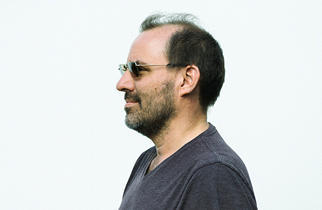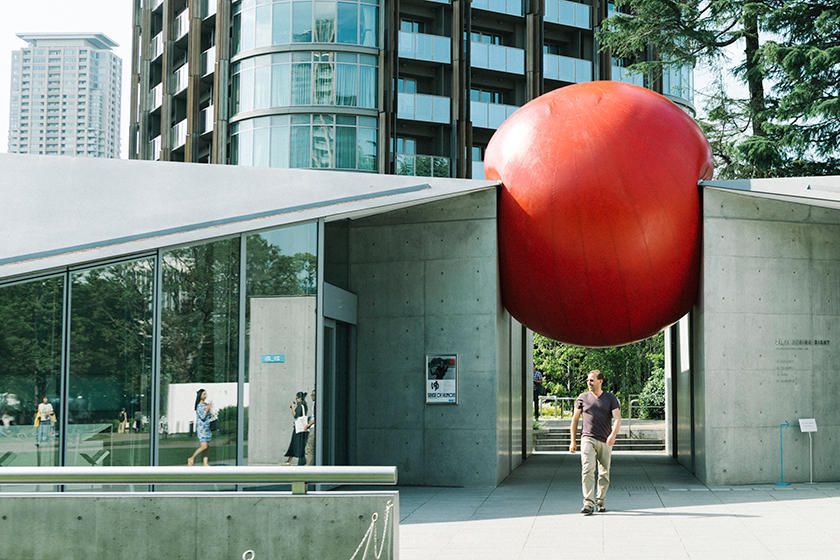
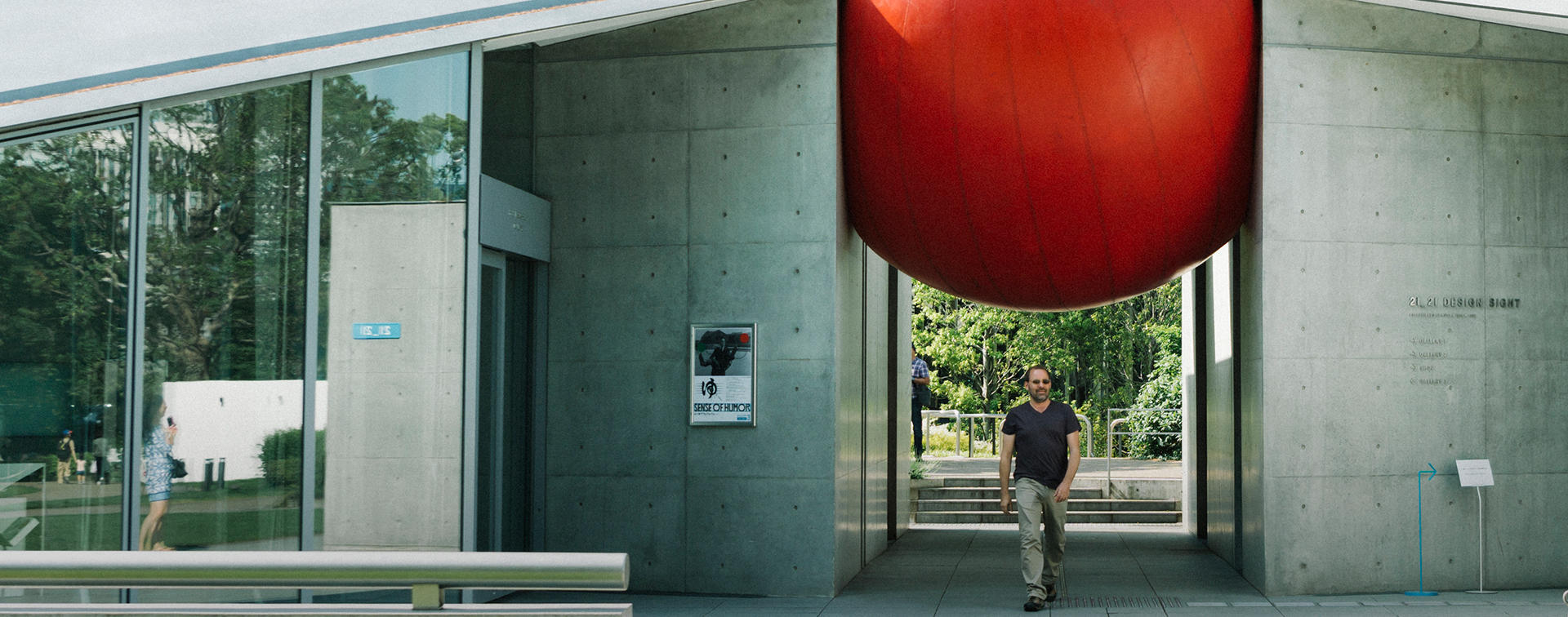
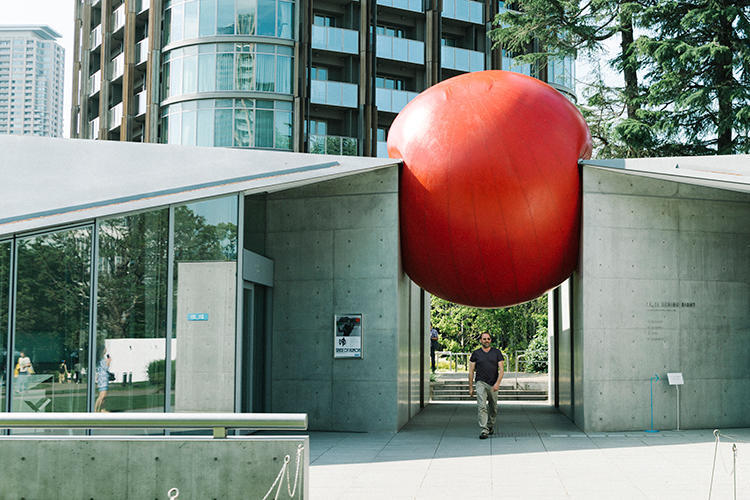
Creating contrasts to the city using art
Moving out of the comfort zone and stepping into public space to update art
A gigantic red ball appeared in the middle of Roppongi streets. The work of art, “RedBall Project”, by American artist Kurt Perschke was a part of the Roppongi Art Night 2019 program. We interviewed Mr. Perschke about the origin of his project exhibited in 32 cities worldwide over the course of nearly 20 years, the relationships he has observed among the artwork, customs and locals of those cities, and more.
From traditional sculptures to public art
I studied sculpture in school and started my artist career as a sculptor. As time went by, I started to wonder what it would be like to move away from the traditional sculpturing and use sculptures to paint cities as canvas as if I was a painter. I wanted to communicate with the people on the street through creating art pieces, which is known as "public art" in the U.S. and "street art" in Europe. This was the origin of "RedBall Project".
People often ask "why a red ball?" My first red ball creation was back in 2001 in St. Louis when the city asked me to create an art piece to display at the foot of a bridge. I wanted it to be something that can convey the grandness of the bridge and sketched the idea over and over with no success. When I thought I had exhausted all my ideas, I nonchalantly drew a big red ball. That big red ball on the piece of paper somehow made me laugh. The following day, I showed the same red ball to the curator and it, again, made her laugh. I guess this is how reputations spread and the artwork becomes known to people. This is the moment when the concept of "RedBall Project" was born.
RedBall becomes an art piece after blending into the site or the environment. People tend to look at the RedBall alone and think of it as the only component to the art piece. But unlike other large sculptures, "RedBall Project" is performance art work using sculptures to paint cities.
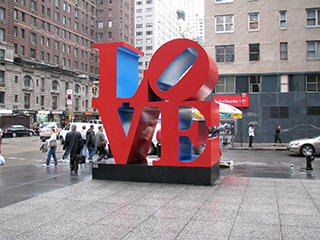
Public Art
Public art is displayed in plazas, parks, on streets and other public spaces that are not museums or galleries. Having connections with the site and establishing a relationship with its surroundings, RedBall is different from monumental objects. It is an artistic piece and is often utilized to give the city a makeover or boost the popularity of the area. Shown here in the picture is public art, LOVE, by Robert Indiana in Manhattan, New York.
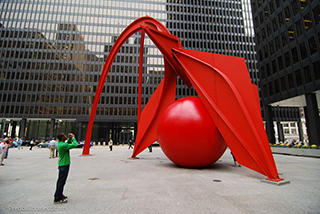
RedBall Project
Since its launch in 2001, this public art project has been running for nearly 20 years. The tour-style project has traveled to 32 different cities worldwide, popping up in different sites within each city from one day to another.
Photo: by Kurt Perschke (An exhibit in Chicago)
Cultural differences observed during the tour in 32 cities worldwide
The project is constantly moving forward and has traveled to over 32 cities worldwide thus far. I do not go back to the same space twice. So it is possible for me to come back to Tokyo in the future, but not again to Roppongi. I am always looking for new environments and that has kept me going for close to 20 years. I am not making a new object every time. Instead every time I make a new idea using the same object. When I use the same object but in different sites, I create new stories each time. So, for me, this process of imagination is the artistic aspect of the RedBall Project.
Once the location is picked, the next step is deciding where to exhibit the RedBall. There are a number of criteria when it comes to selecting the site. I go to the site first to observe and check the impressions I get from the pedestrians, the connection between the exhibition spot and the site, the feasibility of setting up the RedBall for people to touch, the compatibility of the piece and the site, along with other aspects. Some sites come with restrictions and I also examine the technical side of how the sunlight lights the piece. The pedestrians' movements and moods can be affected by the weather so I need to come up with different scenarios and study the characteristics of the site while keeping the project consistent with the rest of the sites to create one story. These are the steps I take to create my performance piece.
Being the simple project this is, I find it very interesting that the cultures of these cities are unintentionally reflected through the art piece, as if the characteristics of the audiences are revealed. The reactions and demeanors of the audiences often are beyond my imagination. The cultural differences between Australia and England were especially interesting. I have brought the project to Australia twice so far. While Australian audiences playfully jumped next to the RedBall and displayed more physical interactions with it, audiences in an outskirt of London sat in front of it and conversed with their company for a prolong period of time. Audiences' reactions change entirely with the site and it always brings good, new surprises.

5 years to realize the first performance in Japan
This performance at Roppongi Art Night was a product of countless discussions. To pick the sites, I visited Roppongi in February of this year to check every corner of the city. Since the reactions of the audiences vary greatly from one season to another or one condition to another, I could not guess how my project would turn out. Being an urban art festival, Roppongi Art Night consequently worked well with the world traveling "RedBall Project".
At 21_21 DESIGN SIGHT, I installed the RedBall at a height that require people to jump slightly in order to touch it. It gave the audiences thrills of an approaching ball, but at the same time, it was at a perfect height to bring out the fun. It enticed people to touch or jump up. These are the two elements I focused on. If the ball was installed slightly higher and my audiences could not touch it, there would never be communications between the art piece and the audiences and it would leave the art piece looking detached from the site. The relationship with the site can really affect the impressions people get from the ball.
This was my first RedBall performance in Japan. On the first day of the performance, I noticed an odd trend; people who photographed with the RedBall were all women. I had eight men as my event crew but none of them took photos with it. I wondered why. I have been to many sites in different cities, but this was something unseen before and I was a bit startled by it. Interestingly, the odd trend was noticeable only on the first day. I am already anxious to see the reactions of the audiences when they see the RedBall at Roppongi Art Night.
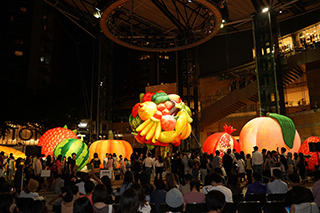
Roppoingi Art Night 2019
Roppongi Art Night is an event to celebrate art, design, music, video, performance and other genres of artwork. The urban art festival, bringing art and city together as one attracts many visitors each year and celebrates their 10th anniversary this year. Choi Jeong Hwa and Kurt Perchke along with other talented artists joined the art festival to put together this year's theme, "Night Journey, Daydream". The festival was held for two days; May 25 to 26, 2019.
©Roppongi Art Night Executive Committee
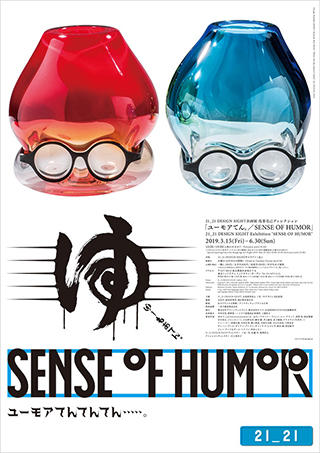
21_21DESIGN SIGHT
Located at Tokyo Midtown, 21_21 DESIGN SIGHT is a facility dedicated to design. The museum, directed by Issei Miyake, Taku Satoh and Naoto Fukasawa, holds exhibitions to promote to understand and to be interested in design. Their current exhibition is "SENSE OF HUMOR" under the direction of Katsumi Asaba and is exhibited from March 15 through June 30, 2019.
Lessons from being in a public space
I am interested in exhibiting and performing art as well as interacting with the people in public spaces, not at museums or galleries. But that is one of the biggest fears for artists. Once we are in a public space, all the restrictions are lifted and we can no longer select our audiences. The audiences may be workers rushing to work or some passersby that happen to be there. The people who come in contact with our artwork are not always there, thinking that they are going to look at art. On the other hand, when the audiences go to museums, they enjoy the viewing of artwork in the environment where prescribed rules and restrictions exist. Museums and galleries provide us a sense of safety because we can predict the behaviors of our audiences.
Exhibiting artwork in a safe context has its own good values but there is also a risk that it can end up being self-complacent. Moving away from this safe context is a true challenge for many artists, and I can only guess the number of the artist that actually do break away from the context is very small. But I believe there are lessons we can learn by taking the risk and that has kept me from doing what I do.
Art that loosens the ideas and stimulates the imagination
RedBall Project is a project in which a red ball travels every day from a site to site. Over the course of a several days, the performance travels to different sites. When people spot the ball, they begin to wonder where the ball will travel to next. This is an experience that cannot be observed at a museum or gallery. Standing in front of an art piece, no one really looks at it and thinks that they would draw it differently. However, with a freely traveling public art like the RedBall, it stimulates the audiences to imagine what they would do and to expand their imaginations.
What is vital for this art to stay lively and not ever be stagnant is to create a flexible environment to actively interact with the society by moving away from a fixed safe context like museums. In that sense, I can say that my public art is not the art for just viewing, but it also is imaginative art that frees the audiences. "RedBall Project" being an example of such imaginative art, I would like to further expand my work and lay out some plans for my future artwork. There are many ways to communicate directly with the audiences and I am going to draw ideas from the reactions of the people I witnessed through my world-traveling "RedBall Project".
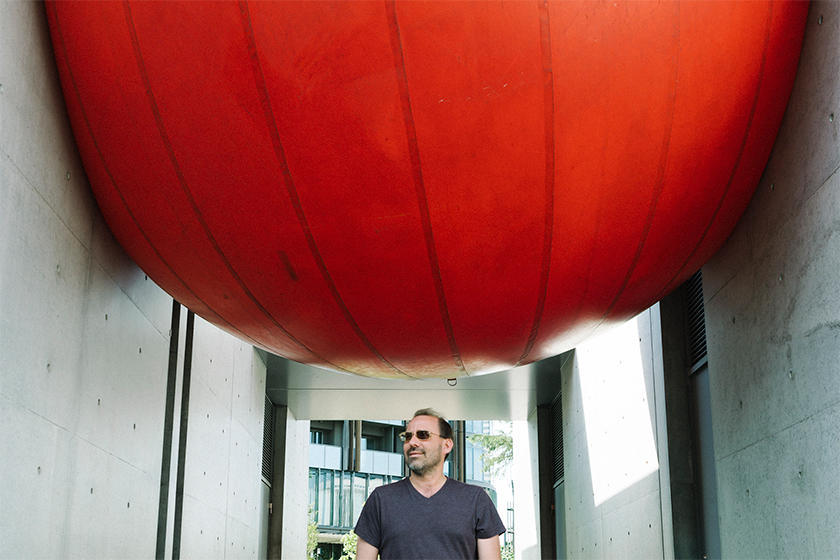
Roppongi, a new city full of refreshing sensations
Roppoingi Art Night is the reason for my first trip to Japan. I get impressions that Roppongi is overall a new city full of beautiful, new areas like 21_21 DESIGN SIGHT and The National Art Center, Tokyo. At the same time, this newness makes it harder to find historical and aged streets. When I looked at Tokyo as a city and the layout of the buildings in different spaces, I felt there were so many different ways to exhibit the projects here in Tokyo compared to the U.S, and that to me was very refreshing.
I have been traveling through cities as an artist alongside the RedBall, and there have been plans for some cities that fell through. One of the most memorable cities was Abu Dhabi. Abu Dhabi started its urban development project around the year 1950 to modernize the city. It might not be considered that long ago in history, but the city features a green concrete bus and taxi station in the heart of the city. I was drawn to the site and proposed it for the RedBall Project. The answer to that was "(The building is) too old and ugly" and the proposal was rejected. I learn a lot about the distinctive attitudes of the city through the process of, and feedback from plans.
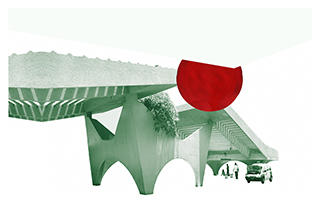
RedBall Project Abu Dhabi
Shown here is one of the sketches drawn by Mr. Perschke for the RedBall Project in Abu Dhabi. The project was held on November 14 through December 2, 2011.
Sketch provided by: Kurt Perschke
Turning the busy business street into a slow-paced space
Culturally, the RedBall Project works like an invitation to reveal the public sense of permission. I have seen people of Roppongi taking pictures of the ball, touching the ball, using their imagination to play with the ball and interacting with the ball in different ways. What I noticed by watching these people was that they all seem preoccupied. I got the impression that the people of Roppongi do not really allow themselves to evade reality and enjoy life freely, or to take a moment and relax. In Tokyo, self-permission is harder. I saw something similar in New York and London. People in busy cities are apprehensive about letting themselves go freely.Art has an important role in creating experiences and contrasts that these cities cannot offer on their own.
We see a great deal of "high" culture in Roppongi. The challenge was to create "low" culture within the bustling high culture. Let's look at local food markets as an example. To go against the fast stream of Roppongi, people will benefit a lot from a nice, relaxing space. Won't it be great if artists can slow down the city with their art?
Each "RedBall Project" normally runs for two weeks at the most. I am currently working on a sculpture project for the summer and it will run for the entire summer. The venue will be able to host events and have space for different programs. "RedBall Project" was a short project but this one I am working on will be a long one. I want the future project in Tokyo to be something that will be exhibited for a long period of time or that has different faces from day to night like Roppongi Art Night.
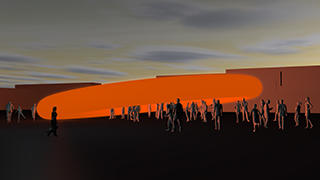
"HARBOR" Project Currently being Worked on
HARBOR is a temporary public space, currently being created, which will pop up this summer. HARBOR will serve as a space where people get together, host events or just hang out. Mr. Perschke originally came up with this vision for a project in Italy.
Photo Provided by: Kurt Perschke
Editor's thoughts
Mr. Kurt Perschke has been exhibiting "RedBall Project" for nearly two decades. The simplicity and "free-spirit" of using only the Redball, has been the source of imagination and ideas for the audiences as well as the artist himself. When looking at the familiar places from different angles, strolling through the street becomes so much more fun. (text_eisaku sakai)














